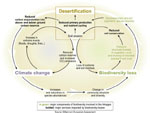Desertificación
Únicamente la versión en inglés ha sido aprobada por el Comité Científico de GreenFacts
Información sobre nuestra estructura de 3 niveles
7. Is there a link between desertification, global climate change, and biodiversity loss?
The source document for this study states:
"Desertification is associated with biodiversity loss and contributes to global climate change through loss of carbon sequestration capacity and an increase in land-surface albedo.
Biological diversity is involved in most services provided by dryland ecosystems and is adversely affected by desertification. Most important, vegetation and its diversity of physical structure are instrumental in soil conservation and in the regulation of rainfall infiltration, surface runoff, and local climate. Different plant species produce physically and chemically different litter components and, together with a diverse community of micro- and macro-decomposers, contribute to soil formation and nutrient cycling. The species diversity of vegetation supports both livestock and wildlife. All plants support primary production that ultimately provides food, fiber, and fuelwood and that sequesters carbon, thus regulating global climate. Excessive exploitation of vegetation leads to losses in primary production and hence also to reduced carbon sequestration. It is the disruption of the interlinked services jointly provided by dryland plant biodiversity that is a key trigger for desertification and its various manifestations, including the loss of habitats for biodiversity (C22 ![]() .2.5, C4
.2.5, C4 ![]() .1) (See Figure 6.1
.1) (See Figure 6.1 ![]() ).
).
The major components of biodiversity loss (in green) directly affect major dryland services (in bold). The inner loops connect desertification to biodiversity loss and climate change through soil erosion. The outer loop interrelates biodiversity loss and climate change. On the top section of the outer loop, reduced primary production and microbial activity reduce carbon sequestration and contribute to global warming. On the bottom section of the outer loop, global warming increases evapotranspiration, thus adversely affecting biodiversity; changes in community structure and diversity are also expected because different species will react differently to the elevated CO2 concentrations.
Desertification affects global climate change through soil and vegetation losses. Dryland soils contain over a quarter of all of the organic carbon stores in the world as well as nearly all the inorganic carbon. Unimpeded desertification may release a major fraction of this carbon to the global atmosphere, with significant feedback consequences to the global climate system. It is estimated that 300 million tons of carbon are lost to the atmosphere from drylands as a result of desertification each year (about 4% of the total global emissions from all sources combined) (medium certainty) (C22 ![]() .5.3, C12
.5.3, C12 ![]() .2.4).
.2.4).
The effect of global climate change on desertification is complex and not sufficiently understood.Climate change may adversely affect biodiversity and exacerbate desertification due to increase in evapotranspiration and a likely decrease in rainfall in drylands (although it may increase globally). However, since carbon dioxide is also a major resource for plant productivity, water use fiefficiency will significantly improve for some dryland species that can favorably respond to its increase. These contrasting responses of different dryland plants to the increasing carbon dioxide and temperatures may lead to changes in species composition and abundances. Therefore, although climate change may increase aridity and desertification risk in many areas (medium certainty), the consequent effects on services driven by biodiversity loss and, hence, on desertification are fidifficult to predict (C22 ![]() .5.3).
.5.3).
Due to strongly interlinked issues and policies between desertification, biodiversity loss, and climate change, joint implementation of the UNCCD, the Convention on Biological Diversity, and the Framework Convention on Climate Change can yield multiple benefits. Environmental management approaches for combating desertification, conserving biodiversity, and mitigating climate change are linked in numerous ways. Typically, these issues were dealt with separately by different conventions and policy fora, which were negotiated and implemented independently of one another, often by different departments or agencies within national governments. Thus, joint implementation and further strengthening of ongoing collaborations can increase synergies and effectiveness (R13 ![]() .2, R15
.2, R15 ![]() .3.3)."
.3.3)."
Source & ©: MA ![]() Desertification Synthesis Report (2005),
Desertification Synthesis Report (2005),
Chapter 6, p.17-18



